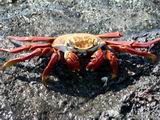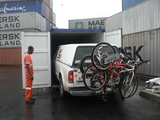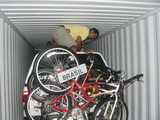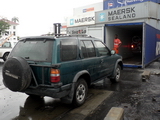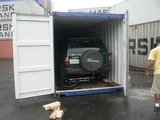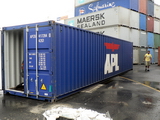 Lietuviskas aprasymas zemiau
Lietuviskas aprasymas zemiau
Wanna see all reports? Click here
Days 82-90: Case Closed. See you in South America!
April 30 - May 8, 2006
After 6 days in the Internet café across the street, the road starts calling us quite loudly! A day at the Canal was a useful escape from the tedious shipping matters, but the truth is that we still have not found any cargo ship, so the fun is over until we make a decision and choose a carrier. USD1050 for a trip with a very cooperative & knowledgeable consolidator, or USD750 for a 20-feet container with APL are the 2 most reasonable choices we have. APL is a huge international shipping company with a good reputation, which normally deals with big businesses and has no knowledge whatsoever about the shipping and customs formalities required from a private party (basically, APL would just lend us a container, but we would be on our own dealing with all the necessary paperwork). The consolidator has no reputation (in the sense that we have never heard about that company before :)), but would take care of the red tape for us. That, however, would cost us additional USD300. All things considered, APL seems to be a better option. We have done tons of customs paperwork by now - how much more different could this case be?
Well, it appeared it could! To start with, the laws in Panama do not accommodate well the situation where a car and its owner are leaving the country separately. There is a way out, however, which involves quite a few visits to the places you would rather stay far away from. First, you have to visit a special police department (PTJ), which verifies if the vehicle ownership documents match the car. That will keep you busy for at least 2 hours, assuming there is no line to stand. A stamp and a signature obtained from there are to be followed by a visit to another police department (a different division of PTJ) for a check if the car is not "wanted by the police" (has not been involved in any accidents or traffic violations). The PTJ permit to export the vehicle is valid for 8 days (these are the days when you can go crazy on the roads in Panama! :)). And finally, you have to go to the customs office and inform them about your intentions to ship the vehicle out of the country. There you will get a vehicle exit stamp into your passport along with a document, which officially cancels the temporary vehicle importation permit you were issued when entering Panama. An exiting addition to the fun is the business hours: the institutions you have to visit open at 9 or 10 o'clock in the morning, take a 2-hour siesta break at 11AM or at noon, and close for the day at 4 or 5PM.
Surprisingly, bureaucracy has a bright side, too! A waiting area of such institutions may be a great place to meet people with similar interests. This was where we met Jane and Jefferson, two Brazilians on a trip home from Florida. J&J were also getting ready to ship their Ford Pickup Camper to Ecuador. Apparently, they had spent less time researching, and were about to pay USD1500 for a 40-feet container. It took us just a few minutes to calculate that sharing one big container between the two vehicles would save us all a good chunk of cash, especially the Brazilians who would have to pay about 1K less compared to their original choice!
Slowly drifting through Panama's bureaucratic canals, we managed to collect all the magic permits in two days. Because of the sudden decision to consolidate the cars, our new co-travelers got to spend some additional quality time repeating the same quest (due to the change of the shipping company some of the paperwork had to be amended), but eventually we were all set for The Loading Day.
Considering the fact that none of the parties involved, including the APL representative, had ever shipped a container with cars to Ecuador, we decided to do the loading one day earlier than recommended. Hence, at 8AM on Friday our 2-car convoy rolled into the Port of Balboa. Maneuvering through a major port full of big trucks and tall cranes constantly zipping among the huge towers of containers feels a little disturbing at the beginning. How on earth are we supposed to find the magic way into that particular APL container, which will carry our vehicles to Ecuador??! Luckily for all of us, the little house with many windows we came across turned out to be the center of all the documentation activities.
The loading procedure is rather straightforward, if you have brought all the required documents properly endorsed. In such a case, all you have to do is go from one window to another collecting another pile of stamped and signed papers, until you are finally allowed to proceed to the loading area. Our window-hopping was going very successfully indeed, until the smooth paper flow suddenly stopped at one of the windows. It turned out we were missing some critical items: the preliminary Bill of Lading emailed to us by APL lacked the container number, and we also did not have a seal for the container. Great!! This gave us an opportunity to visit the APL office, which was conveniently located on the other side of the city, and personally thank our helpful assistant (the APL representative, who had assured us that all we needed for loading the vehicles was a printout of his email).
Having wasted two hours in the busy city traffic we came back to the port with both missing treasures: the container number and the seal. Just when the road to the container finally seemed to be clear, it started raining like crazy! This was when we found out that during bad weather all the port activities were put on hold because it was unsafe for the machinery to operate in heavy rain :). So, the entire place was shut down "until it clears up". Starting the loading one day earlier was a great idea after all! :)
Fortunately, tropical rains are usually short, and another two hours later everything was back to normal. At 3:30PM we were finally given a green light to enter the territory where a nice new APL container was waiting for us. The actual loading was relatively quick and simple. Several helpful port workers quickly secured the cars by blocking the wheels and strapping the vehicles in the container. An hour later, the container was closed and sealed, and at 5PM we were already back in town buying the air tickets for a Monday evening flight to Ecuador. The container with the cars was supposed to leave Panama on Monday morning.
Needless to say, we were extremely happy when boarding the plane on Monday: two weeks of rainy weather, the same small hotel room every day, prolonged Internet and phone sessions in the temporary "office" across the street, and the endless shipping paperwork had started turning our happy trip into hell! Besides, we were truly excited about finally going to the long-awaited Latin America. "Los Diarios de Pathfinder, Part II" is just a couple of hours away!! :)
Tip #1 Air tickets from Panama City to Ecuador are expensive (prices
start at USD350 for a one way 1.5-hour flight), but you can save about USD100
with a student ID. Go to OTEC Travel for student tickets - www.otecviajes.com.
Click on the pictures to enlarge
|
Jefferson's Ford first Pirmasis i konteineri keliauja Jeffersono Fordas |
|
Tight situation :) Ankstoka :) |
|
We are next O dabar - musu eile |
Oooops... forgot the bubble wrap! Oi.... pamirsome ivynioti ivata :) |
See you in South America! Iki pasimatymo Pietu Amerikoje! |
Nuvesk pelyte virs paveiksliuko, spustelk jos kaire ausele, ir paveiksliukas padides
82- 90-oji dienos: Uz kanalo
2006 m. balandzio 30 - geguzes 8
Atostogos prie kanalo baigesi, ir grizom atgal i savo Panamos "ofisa"
- interneto kavine kitoj gatves pusej. Atejo laikas pagaliau apsispresti,
kuriame laive Nissanas plauks i Ekvadora. Atrankai pritaikem pacius griezciausius
kriterijus, nes gi i kruiza isleidziam ne bele ka, o savo istikima keliones
drauga, ir galiausiai issirinkom "APL de Panama" - tarptautine,
gerai zinoma krovininiu laivu kompanija. Vienintelis trukumas - si kompanija
paprastai neteikia paslaugu fiziniams asmenims (taip ir nesupratom, kodel
nusprende su mumis prasideti - tokie smulkus klientai kaip mes jiems visiskai
neapsimoka), todel jos atstovai apie su masinos eksportavimu is Panamos/ importavimu
i Ekvadora susijusius muitines formalumus neturi jokio supratimo - teks visa
popierizma tvarkytis patiems. Vis tik, gera APL reputacija ir viena is geresniu
kainu sugunde, ir nutarem isleisti Nissana su APL. Neblogai pravaziavom jau
kruva pasieniu, kur savarankiskai susitvarkydavom visus migracinius dokumentus,
tai gal kaip nors neprapulsim ir tarp Panamos-Ekvadoro.
Dar vienas APL'o minusas - artimiausias laivas i Ekvadora isplaukia tik uz savaites, todel dar 7 dienas teks prabuti jau gerokai atsibodusiame Panamos mieste. Planas issinesdinti kelioms dienoms is didmiescio i pakrante, deja, zlugo vos pradejus tvarkyti masinos eksportavimo dokumentus. Tvarka - nuostabi! Kiekvienas is pussimcio nenugincijamos biurokratines reiksmes antspaudeliu ir parasu yra gaunamas vis skirtingoje istaigoje. Vienas muitines skyrius - uz puses miesto nuo kito. Gaves viena parasa ar antspauduka, esi siunciamas i kita institucija, kuri ne tik kad greiciausiai bus kitame miesto gale, bet dar ir bus gerai paslepta kokiame nors apgriuvusio sandelio tipo pastate, maziausiai primenanciame vieta, kurioje galetu buti isikurusi valstybine istaiga. Daugumos siu instituciju darbo valandos - is viso sunkiai suvokiamos - ryte atsidaro apie 9-10 valanda, apie 11-12 val. iseina i poros valandu siesta, o apie 4 valanda po pietu darbo diena yra baigta. Darbuotojai - nei paslaugus, nei nepaslaugus. Dauguma tiesiog labai abejingai atlieka akivaizdziai igrisusi darba.
Su biurokratiniais isvykimo is Panamos formalumais butumem susitvarke daug
greiciau, jei ne keistas atsitiktinumas. Sedami viename is tipisku sandeliuku
ir laukdami paties paskutinio anspaudo, pradejom kalbetis su salia prisedusiais
"kolegomis", irgi atejusiais to paties paskutinio antspaudelio.
Isaiskejo, kad lenku kilmes brazile Jane ir brazilas-portugalas Jeffersonas,
vaziuojantys is Majamio i Brazilija, taip pat ruosiasi siusti masina laivu
i Ekvadora. Isgirdus, kiek jie uz tai ruosiasi moketi, mums net plaukai pasisiause
- panasu, kad issirinko viena is brangiausiu kompaniju, o bet to, ju Ford
Pickup Camper su prie galo prikabintais keturiais dviraciais netelpa I 20-ties
pedu konteineri, todel turi imti dvigubai brangesni 40-ties. Greitai paskaiciavom
musu Nissano ir ju Fordo ilgiu suma - turetu tilpti i viena 40-ties pedu konteineri.
Spontaniskai radosi ideja - pasiulem J&J kooperuotis su mumis ir siusti
abi masinas viename dideliame konteineryje su APL. Masinoms kartu plaukti
bus linksmiau, o mums ir brazilams - pigiau. Mes sutaupytumem apie $250, kas
yra geriau, negu nieko; o Jane su Jeffersonu - net apie $1000, kas yra 4 kartus
geriau, negu nieko! Jie, aisku, sutiko :)
Sprendimo kooperuotis deka, likusias dienas visi vel praleidom tarp muitines,
APL ofiso, banku ir Balboa uosto. Pakeitus masinu siuntimo plana, teko keisti
ir kai kuriuos dokumentus; taip pat ieskoti budo, kaip susimoketi APL'ui (nenumatyta
problema - APL dirba tik su firmomis ir mokesti gali priimti tik pavedimu,
o mes banko saskaitos Panamoje, deja, neturime!), issiaiskinti Balboa uosto
darbo tvarka (masinas i konteineri reikia pakrauti likus 2 dienoms iki laivo
isplaukimo, bet, jeigu smarkiai lyja - visa uosto veikla sustoja; o siuo metu
- lietaus sezonas, todel labai rekomenduojama tureti bent viena rezervine
diena).... O vakarais klausydavom J&J istoriju apie Brazilija arba eidavom
sokti salsos.
Labiausiai erzino tai, kad Panamoje viskas vyksta LABAI LETAI ir neorganizuotai, o zmones dirba gana atsainiai. Nepageidaujame, kad kiekvienas muitininkas ar jo sekretore myletu savo darba labiau uz viska pasaulyje, bet visiskas abejingumas galiausiai priveda net ir prie pavyzdingos kantrybes ribos. Pavyzdziui, prognozuojame, kad masinu pakrovimas i konteineri uztruks kokia valanda, ilgiausiai - dvi, ir likusia diena galesim praleisti parke. O uztrunkame visa diena uoste! 8 ryto jau esame uoste ir gera valanda laukiame kazkokio labai veluojancio ir jokiu budu nepavaduojamo virsininko. Jam atvykus paaiskeja, kad neturime kazkokio ypatingai svarbaus simtas pirmojo antspaudo, apie kuri anksciau niekas nebuvo minejes. Sedime dar dvi valandas, kol muitines darbuotojai kazkam skambina ir bando gauti leidima praleisti mus be to antspaudo. Gauna!! Taciau progresas cia ir baigiasi - is karto suzinome, kad neturime plombos konteineriui uzdaryti, kuria turejo duoti APL'as. Reikia vel vaziuoti i kitame miesto gale esanti APL ofisa. Pasiskambinam, nuvaziuojam, ir apie vidurdieni jau griztam su plomba, bet!! - Likus gal puskilometriui iki uosto, pradeda smarkiai lyti :) Isilyja kaip reikiant - su zaibais ir griaustiniu. Del to iki 4 valandos uoste niekas nedirba. Toliau sedim ir laukiam - niekur isvaziuoti negalim, nes gi bet kuriuo momentu gali nustoti lyti :) Apie 5 valanda pagaliau paliekame masinas Balboa uoste, o patys griztam i centra ir ta pacia diena nusiperkam lektuvo bilietus i Ekvadora.
Pirmadieni is ryto isplaukia Nissanas, o po pietu isskrendame mes patys -
pagaliau!!! Neturime nieko pries Panamos sostine, bet... viskam yra ribos.
Dar pora vizitu i biurokratines istaigas, ir, turbut, butumem isvaziave patikrinti,
ar tikrai nera kelio per Darien dziungles!

